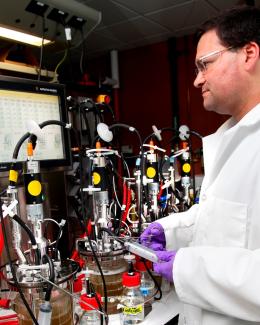Abstract
Hydrothermal liquefaction is a promising technology for microalgae-based biofuel production. However, hydrothermal liquefaction’s aqueous wastes have little established reuse, and contain significant fractions of toxic ammoniacal nitrogen. Careful reuse of this waste can assure microalgae-based biofuels are produced with less environmental impact and larger energy efficiency. Microbial electrolysis cells were investigated to valorize this waste product by converting the leftover organics into hydrogen and remove ammonia. Waste hydrothermal liquefaction aqueous phase from two microalgal strains, Tetraselmis sp. and Chlorella sp. were used as feedstocks for hydrogen production in microbial electrolysis cells. Chlorella and Tetraselmis aqueous phase-fed microbial electrolysis cells reach an average current density of 5.1 ± 0.19 A/m2 and 3.8 ± 0.08 A/m2. Compound removal rates and mass removal percentages were also investigated for each feedstock. Acetic acid, propionic acid, ethanol, and glycerol were effectively removed from the aqueous byproduct. Further, microbial electrolysis cells separated up to 34.3% of ammoniacal nitrogen present in the aqueous phase. Charge transfer analysis indicated that proton transfer, not ammonium transfer, contributed to the majority of the hydrogen production in the cathode. Finally, the microbial electrolysis cell effluent was reused to grow the same microalgal strains, leading to the development of a circular biofuel production system. Microalgae regrowth studies using microbial electrolysis cell effluent showed nearly complete removal of total organic carbon, but significantly less removal of total nitrogen. Tetraselmis sp. growth occurred with the Tetraselmis-derived MEC effluent, however, the control medium without effluent produced the most growth. These findings support the possibility of a circular biofuel framework using MECs, but additional constraints, including the removal of inorganic contaminants, are necessary to realize the circular processes.



